An Interview Between Freya Douglas-Morris and Matt Price
August 2023
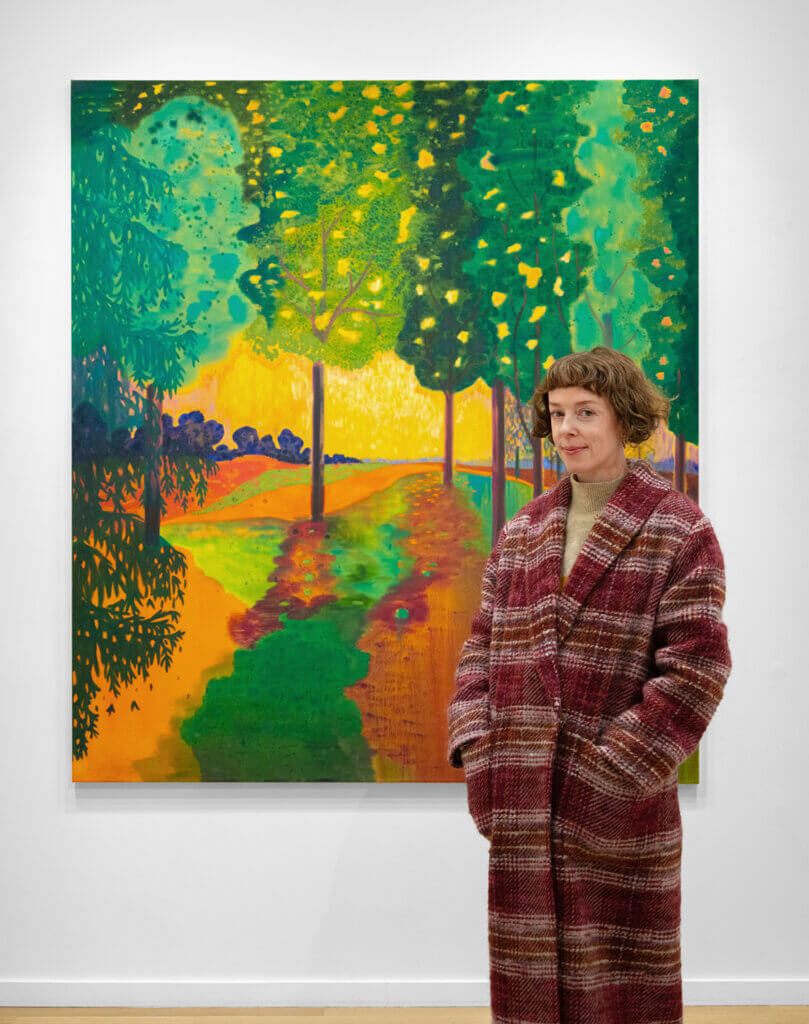
Freya Douglas-Morris with her 2022 painting The places we go.
The following is an edited transcript of a conversation between Freya Douglas-Morris and publisher and writer Matt Price, which took place at Freya’s studio in London Fields, East London, in August 2023. The full transcript can be found in Douglas-Morris’s publication This star I give to you, published by Hurtwood Press in association with Alexander Berggruen.
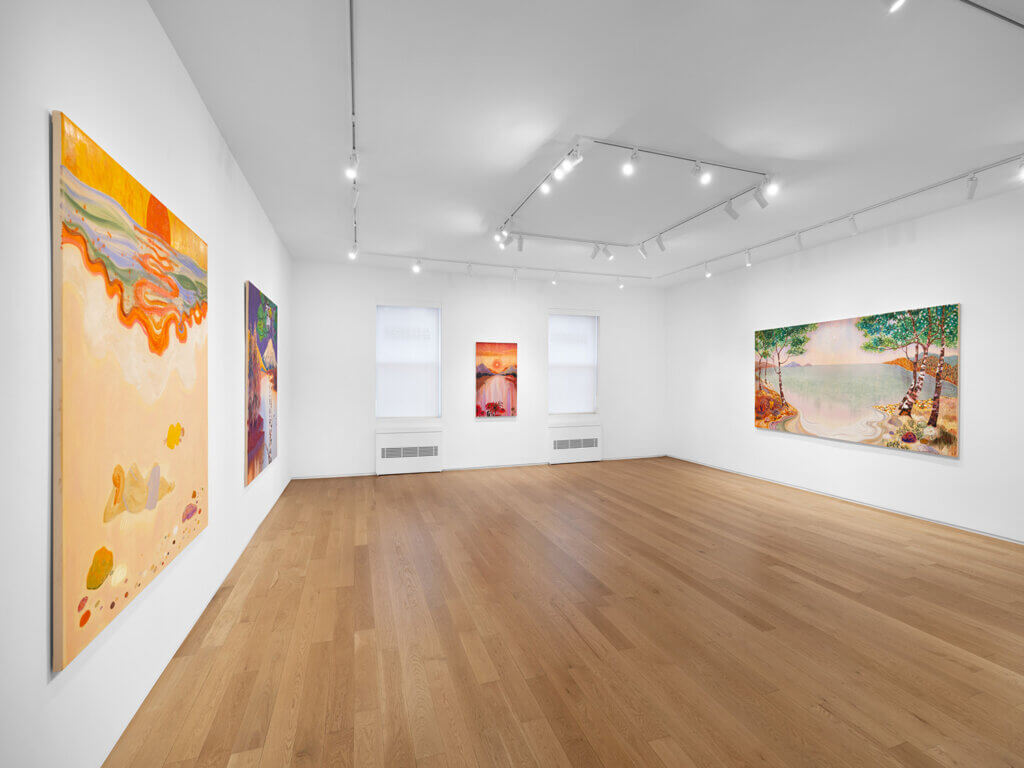
Installation view of Freya Douglas-Morris: This star I give to you (October 18-November 18, 2023) at Alexander Berggruen, NY.
MP: From looking at these works I wonder whether you might be quite an outdoors type.
FDM: I think that’s true; I live in Hackney, London, which is part of a large city but we have a river and the marshes, canals, and nature reserves, wild swimming spots and places to walk. So for an urban setting we’ve managed to find a part of it that allows for a love of nature. I grew up on the Isle of Wight in a village by the sea, so I think my love of being outdoors started then. I like walking in nature.
MP: Is it serious hiking or gentle walks?
FDM: Both. I’ve walked part of the Camino de Santiago in the Northwest of Spain. I went on my own, which was interesting and beautiful. I’d often start walking really early in the morning, sometimes before dawn, because the day would get so hot I’d want to set off as early as I could.
MP: It sounds terribly brave in a foreign country to go out when it’s still black, walking alone.
FDM: But I suppose it’s different from other walks in that there are lots of other people walking as well, so it doesn’t feel that remote. There’s something really communal about it; you don’t feel cut off.
MP: Was the landscape quite arid?
FDM: You go through a lot of different terrain. There were bits that were just bleached and hot, not much vegetation, big plains. But when you first begin the walk you cross the Pyrenees and it’s very lush and misty and dewy. And with all the stones marking the way, there’s something really beautiful about it. I’ve walked a little in Cornwall as well. There’s the Saints’ Way––I walked a part of that when I was pregnant with my first child.
MP: There are Christian connections in these particular routes. Do you have a relationship with faith?
FDM: It’s not really about Christianity as such, but I think there’s something about spiritual routes that I find soulful. Even though you’re walking on your own you feel like you’re walking with history and time and past footsteps. And you know that there’s probably someone just behind you who’s going to be doing the same thing; there’s something really special about that process.

Installation view of Freya Douglas-Morris: This star I give to you (October 18-November 18, 2023) at Alexander Berggruen, NY.
MP: How did you conceive of the exhibition? What were your starting points?
FDM: The first painting I made for it was The places we go [2022]. When I was in New York last summer it was a really hot July and I’d done a lot of walking around Manhattan. I had an evening to myself and I went to sit in Central Park and took a photograph. The light was amazing, and there were all these little fireflies, which we don’t get here—I always associate them with quite magical, nature-filled places, so I was quite surprised. I never knew they had them in Central Park. I’ve only seen them in a few places when I’ve been traveling—I once saw them in Peru. So that heightened the experience for me of sitting in Central Park, and the sun was just setting, pouring through the trees. It had rained a couple of hours earlier so the grass smelt hot and damp, an earthy sweet smell, but it was a bit drier now and everyone had come back outside, sitting in the park again. It was a really simple scene, in some ways quite a domestic park, but also felt quite exoticized with the fireflies and the heat and the sunshine. I took a photograph and thought that I really wanted to make a painting of it when I got back. I didn’t do anything for a few months because I was working on other things and also it sometimes takes a while for ideas to percolate, but then I made that painting at the end of last year. By that time we’d talked about doing the solo show, so I decided to set it aside because it would be really nice if the painting returned to where the image came from. So that was the beginning.
MP: Are your works often inspired by particular places or experiences?
FDM: I don’t often paint specific places, it’s just that this one scene was so fully formed it really settled strongly in my mind. And then I think the rest of the paintings just evolved from there.

Claude Monet
Matin, between 1914 et 1926
three oil “panels” attached to canvas mounted on the wall
78 3/4 x 502 in. (200 x 1275 cm.)
© RMN-Grand Palais (Musée de l’Orangerie) / Hervé Lewandowski
MP: Which came next? Or do you work on paintings simultaneously?
FDM: Yes, I work on them together, especially if it’s a solo show. A solo show is a rare chance to work on many things in a simultaneous experience, rather than working on one, ticking it off my list and then moving on to the next. It’s more that it grows together. Even if you’re making them over a series of months it’s quite nice that they share these connections and energy. I wanted to try making a really big painting, which I’d never done before. And so one of the paintings is ten feet long, which is by far the widest painting I’ve made to date. I wasn’t sure how high to make it, and I actually thought about that for weeks––do I want it to be quite a deep painting as well as wide, or do I want it to be quite a panoramic painting? I had another painting in a group show in Paris earlier this May and I went to Paris for the opening, a really short trip, one night. The next morning I headed off quite early to l’Orangerie and saw that room of the Monet paintings––
MP: The Water Lilies.
FDM: —which I had seen as a teenager and hadn’t had much to say about it. But going back now, and actively going specifically to see them, they were incredible. It wasn’t that busy when I went because it was as soon as it opened, so I got a chance to really see the works. They were so immersive and enfolding. And they were quite long and thin, so that helped me decide that I wanted to make quite a long and thin painting which is why I ended up with these proportions [59 x 118 in.]. It’s called After the rain [2023]. It was the last painting that I made for the exhibition, partly because it took me so long to decide on the dimensions of it, but also because it took me a while to settle on the idea of actually making something so big.
MP: Oh, it’s lovely—really beautiful. I love the treatment of those distant trees.
FDM: There’s some fabric that my mum and dad used to have in our house when I was growing up. It was a Liberty print, a geometric print of diamond shapes, looking like it had been hand-painted with vegetable-dye colors. My mum had a bit of left-over fabric and so she made it into a big cushion which she gave to me and I’ve got it in our kitchen. So I see this bit of fabric every day and ever since she gave me the cushion I feel like the colors keep creeping in. And there’s something quite nostalgic about it.
MP: There’s something that feels sort of seventies about it.
FDM: Well I guess it probably is a bit of fabric from the seventies. I think they had it for quite a few years, when they were living together before having my sister and me.
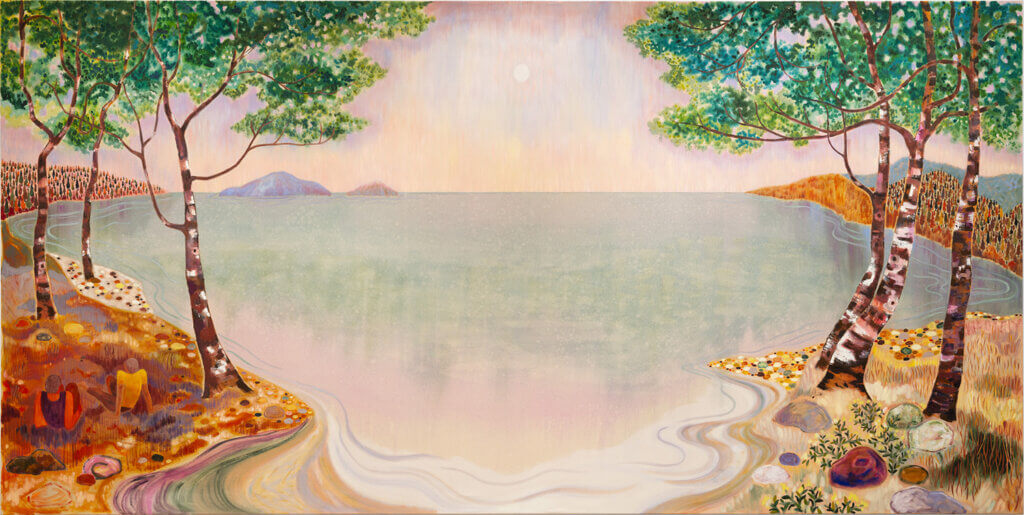
Freya Douglas-Morris
After the rain, 2023
oil on canvas
59 x 118 1/8 in. (150 x 300 cm.)
MP: Is After the rain inspired by a particular experience or place, or a combination of things? Or is it entirely imaginary?
FDM: It’s inspired by different places; I recently visited the Balearic coastline, but also years ago I went walking near Cap de Creus and Port Lligat, where Dalí lived. Both places have a specific kind of colored earth. Thinking of the two places together, they felt like the same geology. It’s like an earthy sand mix, and it’s a mix of terracotta and ocher. It’s not pale or gray, it feels drenched in pigment. And then it’s very dusty and hot but it has this lovely smell of pine, and plants that are growing around and it’s fragrant and rich, and it’s something that just got stuck in my head. I quite like mixing my foliage and botany to make it feel like various overlapping memories. I remember noting that the pines on the coastline weren’t standing up straight, they were all quite craggy, salty, and windswept. So various elements of these memories came to my mind when I was making the painting. And because it was relatively large I wanted the painting to be quite empty, especially in the center, so as not to fill all the space, to focus on the sense of light and atmosphere as opposed to cramming in lots of elements. I wanted it to have this feeling of when it’s rained and the rain’s passed and there’s something that happens to the sky and the ground; it’s hot and wet and damp and shiny, and I wanted all those feelings in a painting. The sky was really bright, like the rain had cleared away any dust and sand that might have been floating in it, but it was also cool, it shimmered in its opposites. And the sea had turned a pale greeny color like Davy’s gray. So I think I was more focused on the atmosphere.
MP: The influence of your Orangerie experience is also there. Impressionism is clearly an element within your painterly language.
FDM: Yes, I think so. To try and paint areas of light—natural light—in a way that is not just one plane of color but using various shades of color to create this slightly shimmery imagery, a restless way of describing light, is very resonant of that.
MP: And there’s a touch in the brushmarks, in the mark-making, that could be Pissarro or Monet or Bonnard, moving through the end of the nineteenth century and towards the Fauves. Your Central Park-inspired painting has much more of the Fauves about it. It’s interesting that you weave together these different art-historical vocabularies into your own.
FDM: I recently went to see the After Impressionism exhibition at the National Gallery. There was a really big Vuillard that was just amazing, I think it’s called Figures in an Interior: Music [1896]. I don’t think I’d seen such a big Vuillard painting in person before. I think of them as usually quite intimate, but this one was big. And it had so many different contrasting elements to it, decorative and busy, and then planes of rich color; it was beautiful to see. There was also a Bonnard retrospective show I think at Tate Modern, in early 2019, and that exhibition also left an impression.
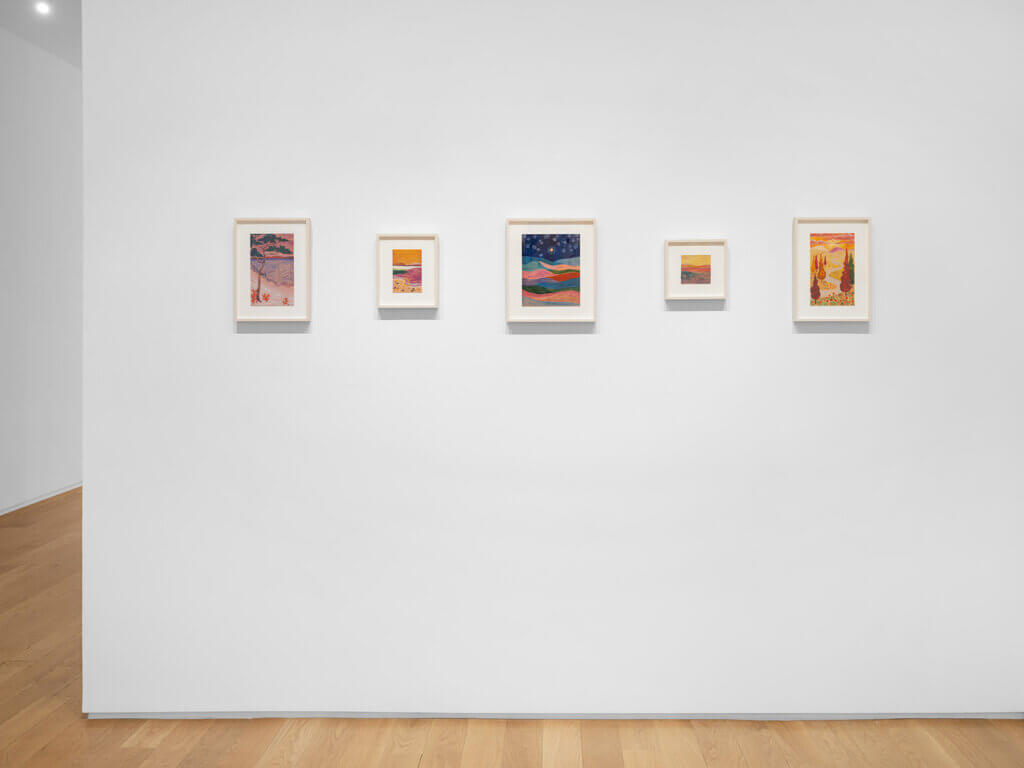
Installation view of Freya Douglas-Morris: This star I give to you (October 18-November 18, 2023) at Alexander Berggruen, NY.
MP: Why did you decide to make and include these gorgeous small works?
FDM: Because the work in the exhibition is predominantly quite large, I wanted to have an area that set a different pace, to punctuate it.
MP: How did you settle on the medium of copper? It’s unusual.
FDM: It’s very different to working on canvas. It dries differently, it sticks differently, it holds differently. It’s a bit more like painting on board than on canvas, but even then it’s less porous, so it’s quite a different feeling. But I wanted to try it out. I’ve worked on board quite a lot over the years, I like the resistance of that sometimes. I wanted to try something that had that resistance and which maybe acted a bit like a paper piece, it was a new inquiry for me. It’s good to have something small to work on, on a day when you’re in between things, or maybe you don’t feel like working on something large scale. When I work on large canvases I’m constantly moving between the wall and the floor, but when I made these I stood at my table, so I’m using my body in a different way, I’m much stiller.
MP: Can you tell me about Friends and lovers [2023]?
FDM: Quite a lot of the titles come from things that I’ve absorbed. I listen to a lot of music when I’m in the studio, on my headphones, and I was listening to a Beatles song—“In My Life”—so it’s a line from that. I didn’t want the figures to be too specific, in the same way that the landscapes aren’t too specific. There’s a sort of tenderness to them and an androgyny, they’re sort of human spaces that you can fit your own associations to, but I like the way that they’re reflecting each other; they’re like each other’s silhouette or each other’s shadow.
MP: This feels a much more distant landscape, more Japanese, Far Eastern. Have you traveled around Asia much?
FDM: Not too much; I’d love to go to Japan one day. I look at Japanese art quite a lot, especially Japanese woodcuts and printing, and I think there’s something about the way I make paintings that often references printing. Even though I’m not really a very skilled or knowledgeable printer, I understand about shapes being placed together, how things are composed, and these aspects are in the painting. This painting Pink moon [2023] could almost be a sort of print, it has some of that quality. Some of the marks I make, I want them to feel like they’ve been gouged, printed on; added on at the tail end of a print run, when things are beginning to dry out a bit.
MP: Sometimes you’ve got these very delineated edges, where the color literally separates with the line, and then other times you have the bleeding, like with watercolor or acrylic. Is it oil or a mixture of oil and acrylic?
FDM: It’s only oil, even that silvery color is oil. You’re right; I think sometimes I deliberately want to leave it like this, the way you might have the color underneath and the color on top, there’s a little gap where your paint might have slipped a little bit, you get that little bleed. I have quite a simple process. I don’t think I have a lot of materials, it’s just tubes of paint, and my only medium is in this jar; there’s an oil and mineral solvent mix and that’s pretty much all I use. So in some ways it’s quite simple, but I think by not using too many different materials I can be more experimental. Sometimes I might add other things, if it calls for it. For example, in this painting Mother and child beach scene [2023] I wanted the child to have a sandy towel––it’s based on a photograph I took of my son last year––I wanted it to have a gritty feeling to it. I thought if I wanted it to feel sandy then the best thing to use is sand, so I took him to the playground the next day and took a little sand back to the studio with me. It felt like the perfect addition to the paint mix––the sand that he was playing in.
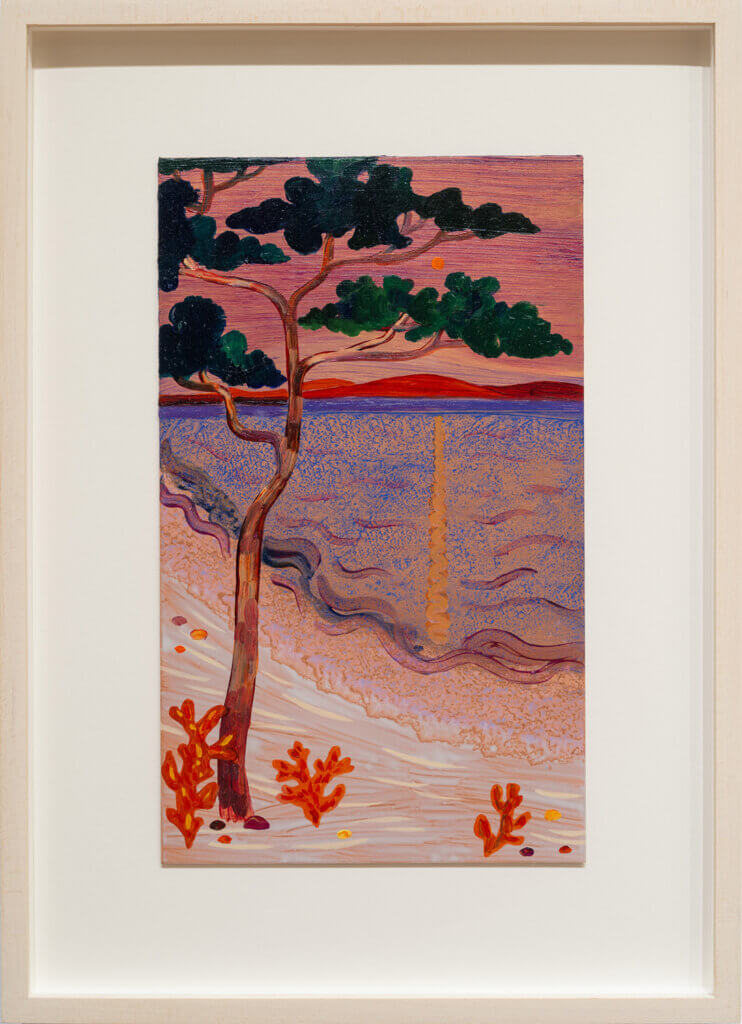
Freya Douglas-Morris
Coral leaf, 2023
oil on copper, framed
9 7/8 x 5 7/8 in. (25 x 15 cm.)
Matt Price is a London-based publisher, editor and writer. He holds a BA in art history from the University of Nottingham and an MA in curating from the Royal College of Art, London. His writing has featured in magazines such as Art Monthly, ArtReview, frieze, and Flash Art, and he is a regular contributor to Art Quarterly, the magazine of Art Fund.
Freya Douglas-Morris (b. 1980, London, United Kingdom) is a London-based British artist. Her paintings have been exhibited internationally in China, Taiwan, The Bahamas, Austria, Italy and France, and in America at Alexander Berggruen, NY and Dallas Contemporary Museum, Dallas, TX. In the UK, her works have been on view at Pilar Corrias, London; Arusha Gallery, Edinburgh; Lychee One Gallery, London; Saatchi Gallery, London; Newlyn Art Gallery, Cornwall, and Liverpool Biennial. She was featured in The Anomie Review of Contemporary British Painting 2 in 2021 and 100 Painters of Tomorrow in 2014. Douglas-Morris’s work is in the collection of the Dallas Museum of Art, TX.
This interview was published on the occasion of Alexander Berggruen‘s exhibition Freya Douglas-Morris: This star I give to you (October 18-November 18, 2023).
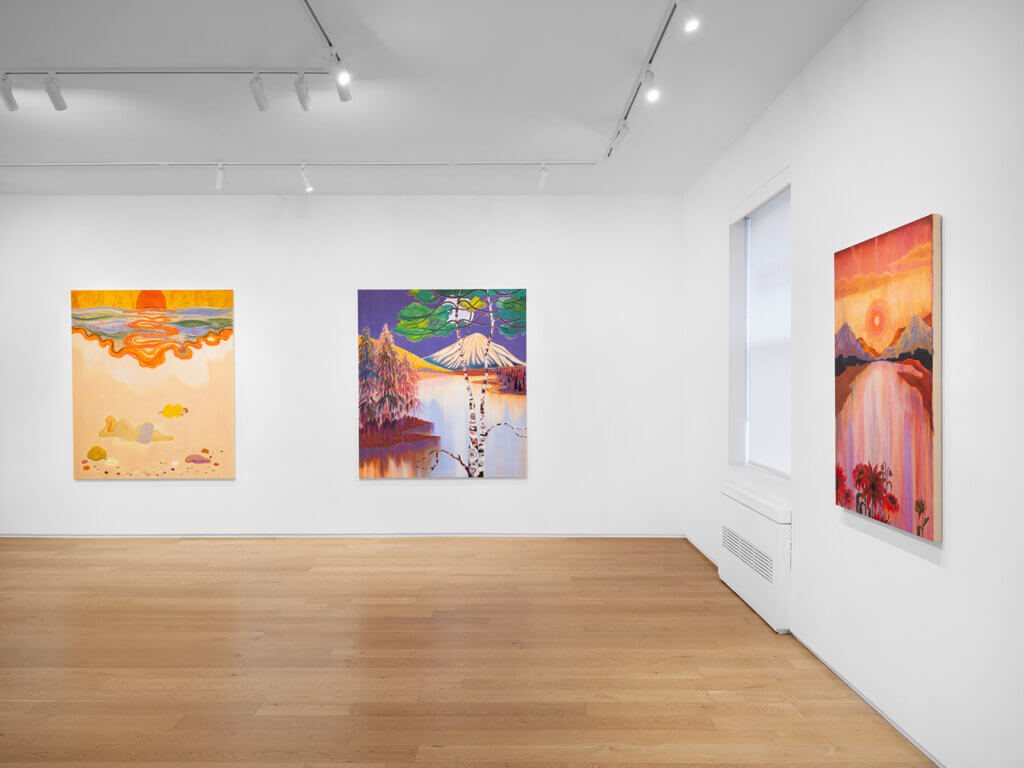
Installation view of Hulda Guzmán: They come from water (May 24-July 5, 2023) at Alexander Berggruen, NY.
Photos: Daniel Greer